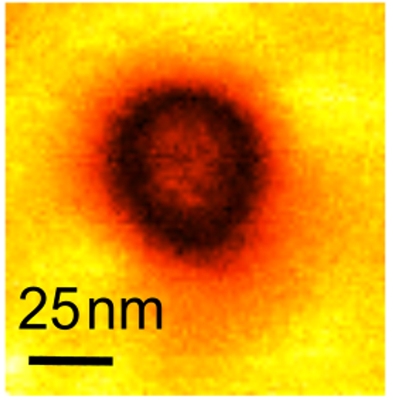Oak Ridge National Laboratory (ORNL) researchers have for the first time demonstrated metallic conductivity in ferroelectric nanodomains, paving the way to widen the use of ferroelectric materials in information storage and nanoelectronics.
 ORNL researchers used piezoresponse force microscopy to demonstrate the first evidence of metallic conductivity in ferroelectric nanodomains. A representative nanodomain is shown in the PFM image above.
ORNL researchers used piezoresponse force microscopy to demonstrate the first evidence of metallic conductivity in ferroelectric nanodomains. A representative nanodomain is shown in the PFM image above.
The research team reported its findings in Nano Letters, a journal of the American Chemical Society. The report describes the team’s demonstration of metallic conductance in a ferroelectric film, which normally behaves as an insulator. The team utilized piezoresponse force microscopy for the demonstration.
According to Peter Maksymovych from the Center for Nanophase Materials Sciences of ORNL, the metallic conductance in a ferroelectric material’s insulating matrix opens up novel opportunities to ‘erase’ or ‘write’ nano-circuits. The interesting fact in an application point of view is the capability of tuning both the order of metallic conductance in ferroelectrics and the type of charge carriers by simply utilizing an electric field. In semiconductors, material composition needs to be changed in order to modify the type of charge carriers.
Maksymovych stated that the metallic conductance behavior of the material can be accurately controlled by continually altering the bias dials. The conductivity varies inversely with the size of the nanodomain, he said. The study also raises basic questions about the correct metallic conductivity mechanism, he added.
Although it used lead-zirconate titanate, a familiar ferroelectric film, for its study, the research team believes that these findings are applicable to a wide range of ferroelectric materials. Sergei Kalinin, senior scientist from ORNL, stated that the team’s further research on mixed-phase, multiferroics and anti-ferroelectrics will disclose a new class of unprecedented electronic properties, opening up new possibilities in both fundamentals and applications.